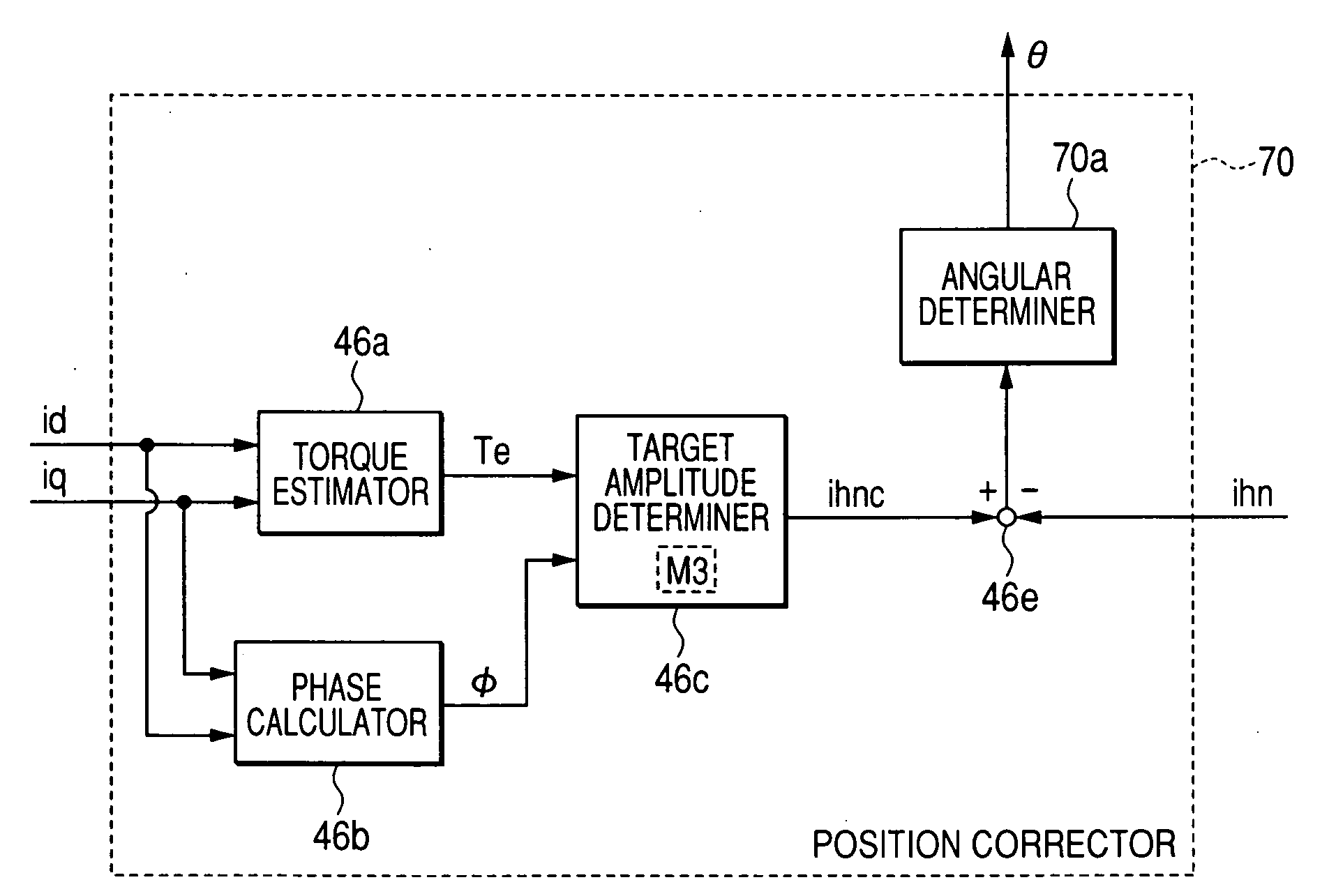Control system for rotary electric machine with salient structure
a control system and rotary electric machine technology, applied in the direction of motor/generator/converter stopper, dynamo-electric gear control, dynamo-electric converter control, etc., can solve the problem that the control system disclosed is difficult to properly obtain and the publication of the control system may be more difficult to properly calculate the rotation angle of the rotor
- Summary
- Abstract
- Description
- Claims
- Application Information
AI Technical Summary
Benefits of technology
Problems solved by technology
Method used
Image
Examples
first embodiment
[0065]Referring to the drawings, in which like reference characters refer to like parts in several figures, particularly to FIG. 1 there is illustrated the three-phase motor 10 and a control system 12 for controlling the motor 10 according to a first embodiment of the present invention. In the first embodiment, the three-phase motor 10 is an IPMSM (Interior Permanent Magnet Synchronous Motor).
[0066]Specifically, the three-phase motor, referred to simply as “motor”10 is provided with a rotor 10a whose cylindrical iron rotor core 10a1 is fixedly fitted around the outer periphery of a crankshaft of an engine installed in the hybrid vehicle.
[0067]The rotor 10a has a salient structure.
[0068]Specifically, as illustrated in FIG. 2, the rotor 10a is provided at circumferential portions of the rotor core 10a1 with a number of such as four, permanent magnet 10a2 each having a substantially arc-shape in its lateral cross section.
[0069]The four permanent magnets 10a2 are so embedded in the oute...
second embodiment
[0210]FIG. 11 schematically illustrates an example of the structure of a control system 12A according to a second embodiment of the present invention. Different structural and functional points of the control system 12A from the control system 12 according to the first embodiment will be mainly described hereinafter. Like parts between the control systems 12 and 12A, to which like reference characters are assigned, are omitted or simplified in description.
[0211]As illustrated in FIG. 11, a controller 16A of the control system 12A includes a dq converter 22a, the command-current setter 24, fourth and fifth adders 25a and 25b, the command-voltage setter 26, the αβ converter 27, the three-phase converter 28, and the PWM signal generator 32. The controller 16A also includes a high-frequency current generator 60, an αβ converter 41a, a dq converter 41b, a high-frequency voltage detector 66, a position detector 68, a position corrector 70, the third adder 48, and the speed calculator 50.
[...
third embodiment
[0240]A control system according to a third embodiment of the present invention will be described hereinafter. Like parts between the control system 12 according to the first embodiment and the control system according to the third embodiment, to which like reference characters are assigned, are omitted or simplified in description.
[0241]In the control system according to the third embodiment, as illustrated in FIG. 13, the target amplitude determiner 46c works to determine the amplitude of the actually propagated high-frequency signal (the α- and β-axis current components ihα and ihβ) associated with the estimated output torque Te, the calculated phase φ of the drive current vector, and the rotation speed ω of the motor 10 (see step S14 of FIG. 9). Specifically, the amplitude of the actually propagated high frequency signal (α- and β-axis current components ihα and ihβ) is changed with change in the RPM of the motor 10.
[0242]The control system according to the third embodiment, in ...
PUM
 Login to View More
Login to View More Abstract
Description
Claims
Application Information
 Login to View More
Login to View More - R&D
- Intellectual Property
- Life Sciences
- Materials
- Tech Scout
- Unparalleled Data Quality
- Higher Quality Content
- 60% Fewer Hallucinations
Browse by: Latest US Patents, China's latest patents, Technical Efficacy Thesaurus, Application Domain, Technology Topic, Popular Technical Reports.
© 2025 PatSnap. All rights reserved.Legal|Privacy policy|Modern Slavery Act Transparency Statement|Sitemap|About US| Contact US: help@patsnap.com



